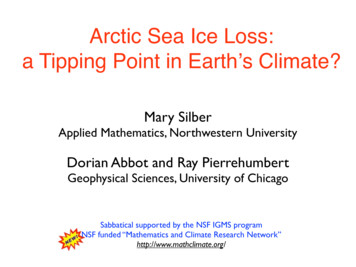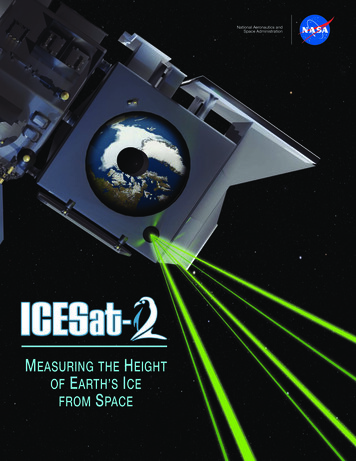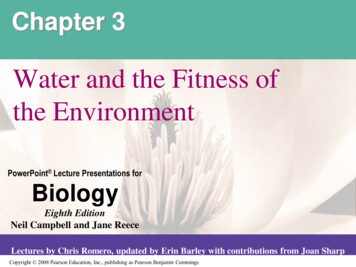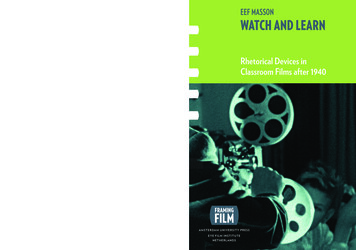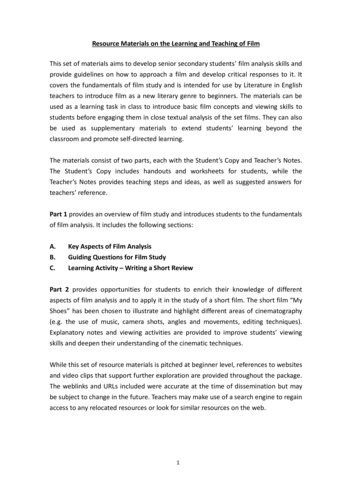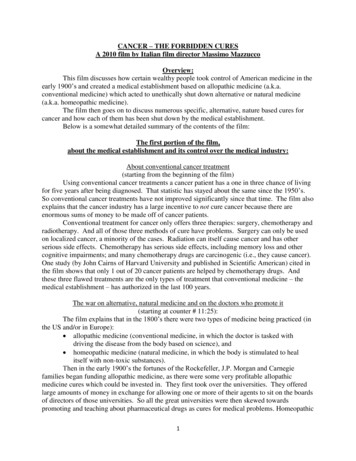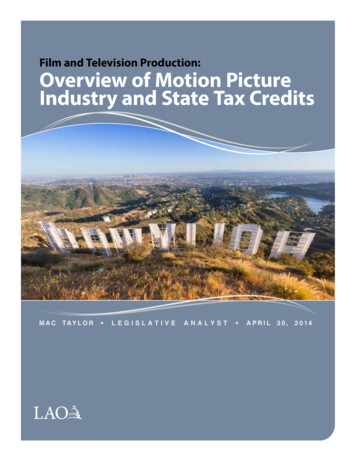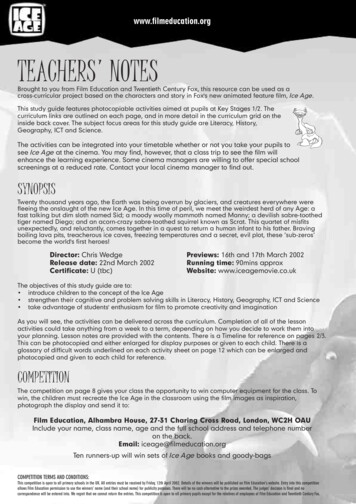
Transcription
www.filmeducation.orgTEACHERS' NOTESBrought to you from Film Education and Twentieth Century Fox, this resource can be used as across-curricular project based on the characters and story in Fox's new animated feature film, Ice Age.This study guide features photocopiable activities aimed at pupils at Key Stages 1/2. Thecurriculum links are outlined on each page, and in more detail in the curriculum grid on theinside back cover. The subject focus areas for this study guide are Literacy, History,Geography, ICT and Science.The activities can be integrated into your timetable whether or not you take your pupils tosee Ice Age at the cinema. You may find, however, that a class trip to see the film willenhance the learning experience. Some cinema managers are willing to offer special schoolscreenings at a reduced rate. Contact your local cinema manager to find out.SYNOPSISTwenty thousand years ago, the Earth was being overrun by glaciers, and creatures everywhere werefleeing the onslaught of the new Ice Age. In this time of peril, we meet the weirdest herd of any Age: afast talking but dim sloth named Sid; a moody woolly mammoth named Manny; a devilish sabre-toothedtiger named Diego; and an acorn-crazy sabre-toothed squirrel known as Scrat. This quartet of misfitsunexpectedly, and reluctantly, comes together in a quest to return a human infant to his father. Bravingboiling lava pits, treacherous ice caves, freezing temperatures and a secret, evil plot, these ‘sub-zeros’become the world's first heroes!Director: Chris WedgeRelease date: 22nd March 2002Certificate: U (tbc)Previews: 16th and 17th March 2002Running time: 90mins approxWebsite: www.iceagemovie.co.ukThe objectives of this study guide are to: introduce children to the concept of the Ice Age strengthen their cognitive and problem solving skills in Literacy, History, Geography, ICT and Science take advantage of students' enthusiasm for film to promote creativity and imaginationAs you will see, the activities can be delivered across the curriculum. Completion of all of the lessonactivities could take anything from a week to a term, depending on how you decide to work them intoyour planning. Lesson notes are provided with the contents. There is a Timeline for reference on pages 2/3.This can be photocopied and either enlarged for display purposes or given to each child. There is aglossary of difficult words underlined on each activity sheet on page 12 which can be enlarged andphotocopied and given to each child for reference.COMPETITIONThe competition on page 8 gives your class the opportunity to win computer equipment for the class. Towin, the children must recreate the Ice Age in the classroom using the film images as inspiration,photograph the display and send it to:Film Education, Alhambra House, 27-31 Charing Cross Road, London, WC2H OAUInclude your name, class name, age and the full school address and telephone numberon the back.Email: iceage@filmeducation.orgTen runners-up will win sets of Ice Age books and goody-bagsCOMPETITION TERMS AND CONDITIONS:This competition is open to all primary schools in the UK. All entries must be received by Friday, 12th April 2002. Details of the winners will be published on Film Education’s website. Entry into this competitionallows Film Education permission to use the winners’ name (and their school name) for publicity purposes. There will be no cash alternative to the prizes awarded. The judges’ decision is final and nocorrespondence will be entered into. We regret that we cannot return the entries. This competition is open to all primary pupils except for the relatives of employees of Film Education and Twentieth Century Fox.
www.filmeducation.orgUSEFUL WEBSITESwww.iceagemovie.co.ukThe film’s official websitewww.filmeducation.orgFilm Education’s award-winning websitewww.bbc.co.uk/beastsAn interactive resource focused on the BBC 'Walking With Beasts' serieswww.nhm.ac.ukWebsite of the Natural History Museum in Londonwww.mammothsite.comWeb pages on mammoths from a museum in Hot Springs, /woollymammoth/Find out about Ice Age beasts through the migration maps and other resourceswww.beringa.com/02/02mania2.htmlRead about woolly enWebsite for the Swedish Museum of Natural History which features resources on mammoths and other enFind out about the rhino of the Ice Agewww.harpercollins.comFind out about Ice Age books from this websiteBackground information on the Ice AgeThe Ice Ages were periods of time when a great deal of the Earth's surface was covered with sheets of ice. The filmIce Age is set during the time of the last Ice Age, which occurred between 100,000 and 10,000 years ago. You mayhave seen examples of the types of beasts who populated the Earth at this time in the BBC series 'Walking withBeasts' (www.bbc.co.uk/beasts). Some of these strange, giant creatures also appear as characters in the filmIce Age, including those on page 4.ExtinctionNo one can say exactly why some animals became extinct at the end of the last Ice Age and why others did not.Some say it was because humans became good hunters whilst others say that animals caught diseases fromhumans. One theory suggests that the warm weather killed them off! Some scientists believe that the current warmclimate is preceding another Ice Age yet to come.Contents and activity notes2/3 Timeline – for reference.4/5 Meet the Cast of Ice Age – these two pages provide an overview of the main characters featured in the filmIce Age.6/7 Ice Age Adventure – this activity requires children to practice their sequencing skills. Read the children the filmsynopsis and ask them to put the images into the order in which they think they appear in the film. Please notethe children will need the images on page 7 photocopied for them to complete the activity.8Recreate the Ice Age in your Classroom! – Competition. Create an Ice Age inspired classroom display andenter photos of it into the Ice Age competition to win computer equipment.9Sound Effects – to make the sound effects for one of the scenes from the film using instruments and objectsfrom the school/home.10 Cave Paintings – in this challenging task, the children are asked to draw a design that will carry amessage to future generations.11 Ice, Ice, Baby – this activity draws on creative writing skills through character role play and diary writing.12 Glossary – explanation of the difficult vocabulary underlined on each page.(Enlarge for the children if necessary.)13 Curriculum Guidelines – details of how each activity fits in the curriculum to ease planning.1
www.filmeducation.orgTIMELINEMiocene Era24 - 5.3 million years ago first large predatoryEocene Era57 - 35 million years agoanimals evolved some animals grew teeth first horses evolved North and South poles wereto eat the grass thatevolvedice free, but the Earth wasgetting ENEOLIGOCENE65-58 Million Years Ago57-35 Million Years Ago34 - 24 Million Years AgoDinosaurs extinctGrasslands emergeFirst horsesPalaeocene Era65 - 58 million years agoOligocene Era34 - 24 million years ago dinosaurs became extinctaround 57 million yearsago world cooled dramaticallykilling 20% of the Earth'sspeciesColour me in!2Look up the underlined words in the glossary on page 12.STEGMIOC24 - 5.3 MilliFirst lpredatory
GADONCENEon Years Agoargemammalswww.filmeducation.orgHolocene Era10,000 years ago to the present dayPliocene Era5.3 - 2 million years ago Pyramids of Egypt were built last woolly mammoths die out modern humans survived first humans evolved Giant mammals ruledthe Earth - but their timewas about to endAMERICAN MASTODONPLIOCENE5.3 - 2 Million Years Ago(luckily for us!)FIRST MAMMOTHSPLEISTOCENEHOLOCENE2 Million - 10,000 Years AgoBegan 10,000 years agoHumans use fireFirst HumansWoollyMammothsPyramidsin EgyptWoolly Mammothsdie outPleistocene Era2 million to 10,000 years ago humans learn to walk upright andto use fire Woolly Mammoths walked theEarth ice covered 30% of the Earth killinganimals, cave men and women last Ice Age occurred in this era Gilderson Print 2002Colour me in too!Look up the underlined words in the glossary on page 12.3
www.filmeducation.orgMEET THE CAST OF ICE AGEHERE ARE SOME OF THE MAINCHARACTERS FROM THE FILM ICE AGESCRATThe 'scrat' is the one imaginary animal in the film,Ice Age. This acorn obsessed slapstick star is onlyreal on screen, but he is based on the earliestmammals that walked the Earth. These lookedlike a cross between squirrels and rats. They lived atthe time of the great dinosaurs. They stayed alive alot longer than the dinosaurs though - about 155million years longer!Scientists in Siberiahave excavated a20,380-year-oldWoolly MammothMANNYWoolly MammothWeighing 6-8 tons, the average woolly mammoth needed 40 gallonsand 600 pounds of vegetation a day in order to stay alive. That isa lot of greens! Manny is covered with a thick shaggy coat ofwoolly fur like the rest of his species. This is to keep him warm inthe cold climate. He also has four inches of insulating fat and ahump of extra fat on his back to help him survive the extreme cold.Manny's trunk has fleshy bits on the end like fingers thatcan wrap around objects. He uses his tusks to ploughthrough the snow to help him find foodSIDGiant SlothSid is a six-foot-tall, 1,500-pound primitive mammal related to the modern-dayarmadillo and small tree sloths of Central and South America. He has flatgrinding teeth to help him chew his food. He likes to eat grass, leaves andbushes. Sid's enormous claws are great for gathering bits of food together. Hehas a funny walk: this is because prehistoric sloths walked on their knucklesand the sides of their feet due to their big claws getting in the way!DIEGOSabre-toothed TigerDiego is as big as a lion. He has big, strong front legs,short hind legs and a short tail. He cannot run very fast,so he prefers to lie in wait for small mammals to crosshis path. Diego’s teeth are extremely sharp anddangerous, and he is not scared to use them when heis hungry.4Look up the underlined words in the glossary on page 12.
www.filmeducation.orgColour me in!FRANKShovel-nosed RhinoThis is the Ice Age relative of themodern rhinoceros. It had arather unusual nose. It fed ongrasses or shrubs. Shovel-nosedrhinos had an odd number of toeson each foot. The ones seen inIce Age each have three.ROSHANBabyRoshan is a human baby. His parents areNeanderthals, or early humans. He has beenseparated from his family by a pack of angrysabre-toothed tigers.QUESTIONS1. WHAT CAUSED THE ICE AGE TO END?2. WHAT HAPPENED TO THE UNUSUAL ANIMALS DESCRIBED ABOVE?Activity 1Use a library or the internet to find out the answers to the questions above and write astory plan for your version of the sequel to Ice Age called Ice Age 2 - the Big Melt. Whatwill happen to each character?Activity 2The 'scrat' is the only invented animal for the film Ice Age. It is a cross between a squirreland a rat. Invent another animal for your sequel. You can combine the features andhabitats of two or three animals. Draw or paint your animated hero and give him/hera name.After you have seen the filmWrite a brief description of your favourite character as if you were being interviewedon a film review programme.Curriculum focus: Literacy, English Language, History, ICT, Science, Art & Design,Environmental StudiesLook up the underlined words in the glossary on page 12.5
www.filmeducation.orgICE AGE ADVENTUREThe characters in the film Ice Age have manyadventures. You can guess some of them byreading the synopsis below.Activity 1Colour me in!In groups, read the following synopsis. Cut outthe four pictures that your teacher will havegiven you and put them into the right orderaccording to the story from the synopsis.The woolly mammothevolved from a smallanimal that lookedlike a pigA synopsis is the whole story from the film toldin a few lines.SYNOPSISIce Age is a film that tells an imaginary storyabout three different animals who lived a longtime ago, and a human baby named Roshanwho has been separated from his family by apack of sabre-toothed tigers. At first, Manny awoolly mammoth, Sid a giant sloth, and Diegoa sabre-toothed tiger, are not friends. However,they learn how to work together and trust eachother to help save Roshan.6The animals carry Roshan through river valleys,forests and glaciers to return him to his father,but danger is always nearby because they arefollowed by the herd of sabre-toothed tigers.One of the many exciting parts of the storyhappens when a volcano suddenly eruptsunderneath the glacier the animals are walkingacross. Manny must use all his strength to keepDiego from falling into the volcano.Look up the underlined words in the glossary on page 12.
www.filmeducation.orgActivity 2Cut these pictures out and put them in the order in which they appear in the film, according tothe synopsis.Activity 3 Draw the next four images according to what you think happens after this exciting event.After you have seen the filmStoryboard your favourite part of the film.Curriculum focus: Literacy, English Language, Art & DesignLook up the underlined words in the glossary on page 12.7
www.filmeducation.orgCOMPETITION!RECREATE THE ICEAGE IN YOURCLASSROOM!THE FILM ICE AGE USES ANIMATION TO SHOWWHAT IT MIGHT HAVE BEEN LIKE TO HAVEBEEN AROUND AT THAT TIME. CREATE YOUROWN VERSION FOR A CLASSROOM DISPLAYAND WIN A COMPUTER FOR YOUR SCHOOL.Scene 1Scene 2Competition - Deadline:Friday 12th April 2002First, create your background setting. Chooseone of the Ice Age settings opposite forinspiration (Scenes 1,2 and 3). Then drawsome animals – use the characters from thefilm to help you.The class who designs the best Ice Ageinspired collage will win a computer for theirschool. Ten runners-up will win a set of Ice Agebooks and a film goody-bag. Good Luck!You can use any kind of materials to makeyour collage: paint, photographs, pencils,pens, clay, junk, whatever you like, just aslong as it shows what you think the Ice Agewas like, inspired by the film.Scene 3Ask your teacher to take a picture of thecollage and send it to Film Education.(NB: Teachers. Competition details within Teachers’ Notes onthe inside front cover of this guide.)After you have seen the filmDraw your favourite character in amodern-day setting, like a skate boardingpark or a shopping centre. Write a list of thekind of problems your favourite characterwould have in this setting.Curriculum focus: History, Geography, Art & Design, Environmental Studies8Look up the underlined words in the glossary on page 12.
SOUND EFFECTSFor animated movies like Ice Age, there is ateam of sound effects artists who useinstruments and all kinds of objects to createthe sounds and animal noises on screen.The Ice Age was a timeof extreme weatherconditions: extremecold and extreme heat,in fact, when it waswarm it was muchwarmer than today'sspring and summertemperaturesThere is one scene in the film when Manny thewoolly mammoth and Sid the sloth are caughtin a rain shower that turns into a hail storm.Activity 1Activity 2Using instruments and objects, recreatethe noise of a rain shower turning into ahail storm. Empty plastic bags makeexcellent instruments for rain if you rustlethem in your hands.Record your hail storm and play it toanother class or the rest of the school inassembly. Did they guess what you werecreating?Colour me in!After you have seen the filmMake up a song or rap about the friendship that grows between Manny, Sid and Diego,the sub-zero heroes!Curriculum focus: Music, Geography, Environmental StudiesLook up the underlined words in the glossary on page 12.9
www.filmeducation.orgCAVE PAINTINGSIn one scene in the film Ice Age, Manny the woolly mammoth,Sid the sloth and Diego the sabre-toothed tiger find some cavepaintings drawn by prehistoric man. The paintings come to lifein Manny's imagination. The pictures show some humanshunting a group of mammoths.You could say that cave paintings were the earliest form ofmoving images or movies: they told stories of how prehistoricman and woman lived.Pictures can show us important things about the world. If youwere going to draw a cave painting that you knew was goingto survive for hundreds of thousands of years, what would youdraw?There were fourspecies of mammoth and not all of themwere woolly!ActivityIn the space below, draw your own 'cave painting' then write a sentence about it.Imagine you are trying to communicate with people in the future who might look at yourdrawing as evidence from the past.After you have seen the filmWrite down the feelings and emotions that you think Manny felt when he saw the cavepaintings. Use the words to write a short poem about what Manny went through. Youmight like to use the glossary on page 12 to help you.Curriculum focus: Literacy, English Language, History, Art & Design,Personal, Social and Health Education, Environmental Studies10Look up the underlined words in the glossary on page 12.
www.filmeducation.orgICE, ICE BABYThe first mammothswere around10 million yearsafter the dinosaursColour me in!In the film Ice Age, Manny and Sid are on a mission to return ahuman baby to his father. Whilst they are trying to find the father,they learn that babies need to be looked after!ActivityWrite a diary for a day in the life of Mannyor Sid describing what it was like trying tolook after a human baby. Write as if you areManny or Sid. Include explanations of howyou learnt about the following:There were mammothson Earth when thePyramids of Egyptwere built - 3,800years agochanging the nappycarrying the baby safelygetting rid of the baby's wind (make himburp over your shoulder by patting its back!)making the baby laugh (play with the baby)feeding the babyAfter you have seen the filmWhich of the characters (Manny, Sid or Diego) do you think made the best parent? Why?Curriculum focus: Literacy, English Language, Personal, Social Health EducationLook up the underlined words in the glossary on page 12.11
www.filmeducation.orgGLOSSARYplough – to cut into something, usually soil or the groundpredatory – animals that hunt other animalsprefers – likes betterprehistoric – a time long ago, before anything waswritten downprimitive – at an early time in historyregions – placesrelated – belonging to the same familyrelative – someone in the same familyrepresent – to show or describerhinoceros – a large animal with thick skin and ahorn on its nose, from Africascientists – men or women who are experts inscienceseparated – divided or kept apartsequel – the story or film that carries on the story ofan earlier story or filmsetting/settings – the place or places where astory happensshrubs – woody plantsSiberia – a cold country in Russiaslapstick – a type of comedy that uses practicaljokes e.g. falling downsloth/sloths – an American animal that lives intrees. Sloths move very slowlyspearing – cutting something with a sharp objectspecies – a group of animals that belong to thesame familystoryboard – a series of pictures, like a cartoonstrip, but without the speech bubblessurvive/survived – to carry on livingsynopsis – a short version of a storytemperatures – how hot or cold something istusks – horns or long teeth that you can see outsidethe mouth of some animals, like the elephantunusual – differentupright – standing on two legsvalleys – long low areas between hillsvegetation – plantsvictim – someone who is hurt by something elsevolcano – a mountain or hill that has hot liquidsinside it (lava)woolly – covered with thick wool (fur)Words to describe emotions (page 10)All of these words might describe how Manny feelswhen he sees the cave paintings. If you do notknow what they mean, look them up in a dictionary. blue broken-hearted emotional gloomy lonely sad upset weepy(NB Teachers: If necessary photocopy and enlarge for the children.)according to – as said by or as said inadapt – changeanimation/animated – a film made using lots ofdrawings, like a cartoonarmadillo – a small animal with a hard shell-likeouter coat that lives in South Americacarved – cut into materialscharacters – the people or animals in the storyclaws – the pointed nail at the end of an animal's orbird's footclimate – the weather patterns of an areacollage – a piece of art made using different typesof materials like paper, paint, cloth etc.combine – to joincommunicate – to pass news on, to talk to peoplediary – a way of writing down what happens to youevery dayera – a time in historyerupts – explodesevent – something that happensevidence – anything that proves that somethingexisted or happenedevolved – to grow into something else over a longperiod of timeexplanations – facts that explain somethingextinct – no longer alive or existingextreme – very great or at the end of somethingfeatures – the things that make something stand outglacier/glaciers – a big river or stream of ice movingslowlygrasslands – a big area covered in grassgrinding – crushing things (in this case, with teeth)habitats – the natural place for a plant or animal to livehind – backimaginary – not real, made up in the mindinclude – treating something as part of the wholeinspiration – a sudden, brilliant ideainsulating – keeping warminterviewed – having had a formal meeting ordiscussion with someoneinvent/invented – to design or make up something newknuckles – finger or feet jointsmammal/mammals – type of animals who providemilk for their babiesmammoth/mammoths – a big type of elephantwith a hairy coat, now extinctmigrated – to leave one place and settle in anothermission – a special type of work or jobNeanderthals – a type of human from long ago,now extinctobjects – something that can be seen or touchedobsessed – to think about one thing all thetimeoccurred – happened12
www.filmeducation.orgCURRICULUM GUIDELINESScottish GuidelinesEnglish National CurriculumMeet the Cast of Ice Y5,Y6,KS1KS2KS1KS2KS1KS2Ice Age AdventureNLSRYY1,Y2,Y3,Y4,Y5,Y6,Art & ,d,e 8c 9b2a 3a,b,f1a,b,c,f 2b 9b2a,c2b,c 3a,c,d 4c 9b1b,d 2a 9a,b4,11,12T2,10,14T1,10 T2,4,14 T3,9T2,3,6,8,10 T3,5,10,12T1,1,2,4,9,10T1,3,15 T3,7,8T1,7,8 T2,1,71a,b 2a,b 3 4a,b 5 6d1a,b 2c,d 3 4a,b 5a,c1a,c 5b1a,c 5b2g1b, 2f, 4bSC1SC2Breadthof study 1c, 2aSC21a, 5b,c,d,eBreadthof study 1c, 2aTLTLTLTLTLTLTL4,11,12T2,10,14T1,10 T2,4,14 T3,9T2,3,6,7,8,10 T3,5,10,12T1,1,2,4,9,10T1,3,15 T3,7,8T1,7,8 T2,1,71a,b 2c 5a1a,b,c 3b 5aRecreate the Ice Age in your ClassroomHistoryKS11a,b 2a,b 3 4a,b 5 6dKS21a,b 2c,d 3 4a,b 5a,cGeographyKS11a,d 2d 3a,b,c,d 4a,bKS21a 2d 3a,b,c,d,e 6c,dArt & designKS12a,b,c 3a,b 4a,b,c 5b,c,dKS22a,b,c 3a,b 4a,b,c 5b,c,dSound EffectsMusicCave PaintingsNLSHistoryArt & DesignPSHEIce, Ice BabyEnglishNLSKS1KS21b,c 2a,b 3a,b 5c1b,c 2a,b 3a,c LKS1KS2RYY1,Y2,Y3,Y5,Y6,EN3EN2TLTLTLTLTLTL1T2,9 T3,5T1,11 T3,5T2,1T1,3 T2,6,8T3,1,42a,b 6a,d2c,d2a,b,c 3a,b 4a,b,c 5b,c,d2a,b,c 3a,b 4a,b,c 5b,c,d1b, 5c1a, 5a9c9a 3 9a12 14 15T1,9 T2 25 T3,13,20T2,13T1,22 T3,10,12T3,7T1,6Meet the Cast of Ice AgeEnvironmental Studies ScienceEarth & space: Earth in spaceEnergy & forces: changing materialsliving things &the processes of life: the processes of lifeinteraction of living things with their environmentEnvironmental Studies Knowledge & Understanding,people in the pastChange & continuity, cause & effectTime & historical sequencePeople & place: the physical environmentEnglish LanguageListening: Listening in order torespond to textsReading: Reading for information awareness of genreWriting: Imaginative writingInformation &Communications TechnologyDeveloping ICT capabilityUsing the technologyCollecting & analysingSearching & researchingArt & DesignUsing materials techniques, skills & mediaInvestigating visually & recordingIce Age AdventureEnglish LanguageArt & DesignListening: Listening in order torespond to textsReading: Reading for information awareness of genreWriting: Imaginative writingUsing materials techniques, skills & mediaInvestigating visually & recordingRecreate the Ice Age in your ClassroomArt & DesignUsing materials techniques, skills & media;Investigating visually & recording,Using visual elementsExpressing feelings, ideas & solutions;Creating & designing, CommunicatingEnvironmental Studies Knowledge & Understanding,people in the pastChange & continuity, cause & effectTime & historical sequencePeople & place, the physical environmentCB, CA-CA-CA-CSound EffectsMusicUsing materials, techniques, skills & media;Investigating, exploring sound,Using instrumentsExpressing feelings, ideas, thoughts & solutions;Creating & designing,Communicating & presentingEvaluating & appreciating;Observing, listening, reflecting,describing & respondingEnvironmental Studies Knowledge & understanding,People & place, the physical environmentA-CCave PaintingsEnglish LanguageArt & DesignA-CWriting: personal writingExpressing feelings, ideas & solutions;Creating & designing, CommunicatingHealth EducationTaking responsibility for healthEmotional healthEnvironmental Studies Knowledge & Understanding,people in the pastPeople, events & societies ofsignificance in the pastIce, Ice BabyEnglish LanguageHealth EducationWriting: functional writingPhysical, emotional & social healthA-CA-CA-CA-CA-CA-CA-CA-C13
Find out about Ice Age books from this website Background information on the Ice Age The Ice Ages were periods of time when a great deal of the Earth's surface was covered with sheets of ice. The film Ice Ageis set during the time of the last Ice Age, which occurred between 100,000 and 10,000 years ago. You may
